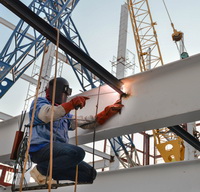The U.S. Department of Commerce on July 8 found that government subsidies to Canadian exporters of fabricated structural steel (FSS) were not large enough to justify any new countervailing duties. In contrast, the agency found that unfair subsidies provided by the other two implicated countries warrant new duties in the range of 13% (Mexico) to 36% (China). ( Commerce Dept. Fact Sheet , July 8)
Survey.
 |
|
Fabrocated structural steel is a key material used in constructing the superstructure of major real estate and infrastructure projects, including high-rise developments, bridges, parking decks and ports. |
- FSS is a key material used in constructing the superstructure of major real estate and infrastructure projects, including high-rise developments, bridges, parking decks and ports. (Roundtable Weekly, March 8)
- A countervailable subsidy is financial assistance from a foreign government that benefits the production of goods by foreign companies and is limited to specific enterprises or industries, or is contingent either upon export performance or upon the use of domestic goods over imported goods. Canada’s FSS subsidies were determined to be at de minimis levels of less than 1 percent and therefore do not warrant tariffs. (GlobeNewsWire, July 9)
- As a result of its preliminary decision, Commerce will instruct U.S. Customs and Border Protection to collect cash deposits from importers of fabricated structural steel from China and Mexico. (The Straits Times, July 9)
- In 2018, FSS imports to the United States were valued at $897.5 million from China; $622.4 million from Mexico; and $722.5 million from Canada, according to the Commerce Dept.
- The Roundtable wrote to the U.S. International Trade Commission about the FSS issue in March and Commerce Secretary Wilbur Ross in June, urging a cautious approach to the investigation and emphasizing the potential economic harm that new tariffs could cause.
- Separately, the quasi-judicial FSS investigation will determine whether exporters in the three countries have engaged in unfair dumping, which could also lead to new duties. Dumping occurs when an exporter sells a product in the United States at a price that is below “normal value,” such as the price at which the foreign producer sells the merchandise in its own domestic market.
Preliminary determinations on dumping are expected on September 5, and final determinations on the countervailing subsidies are expected on November 18.



